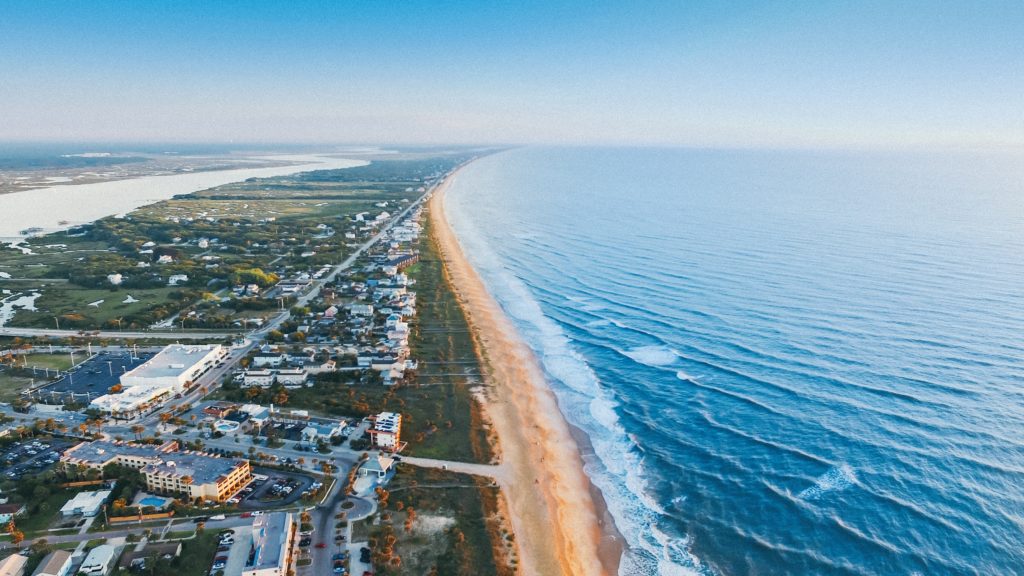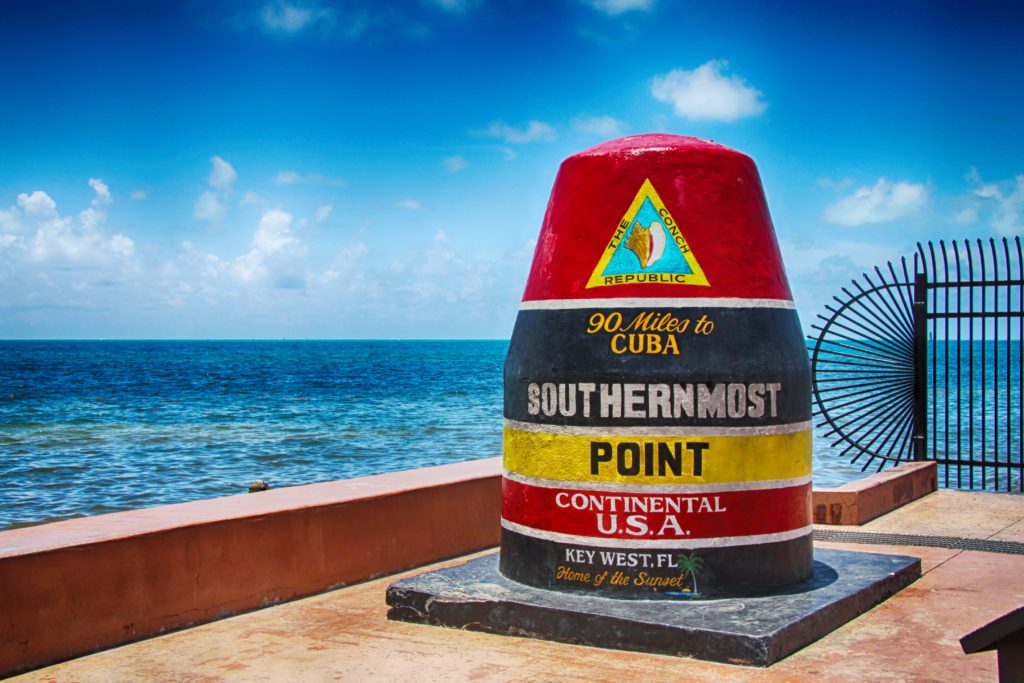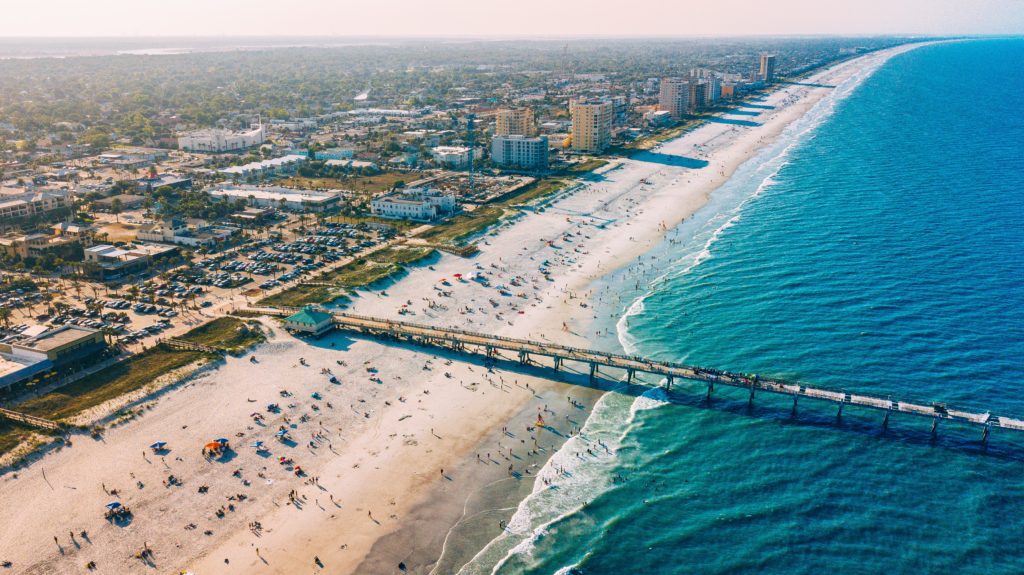Florida is a large and diverse state with fascinating history, natural beauty, and visit-worthy landmarks. Florida beaches are beautiful, the oranges grow readily on trees, and the mullet fish are always a moment away from tossing themselves into the air.
Learning about history and culture can be tedious sometimes. But, Florida offers many interesting facts for children. Below are 16 of the most fun facts about the Sunshine State. From alligators and shark teeth to baseball and amusement parks, Florida offers many historical landmarks and entertainment attractions and yields many exciting facts.
- 1. Ponce de León Named Florida
- 2. Home to the Oldest City in the United States
- 3. Hosts Major League Baseball’s Spring Training
- 4. Launches Astronauts into Space
- 5. Largest Number of Theme Parks in a Single Place
- 6. The Southernmost Point of the Continental United States
- 7. Alligator is the Official State Reptile
- 8. No Dinosaur Fossils in Florida
- 9. Underwater Coral Reefs
- 10. More than Oranges
- 11. Largest City in the United States
- 12. Bring on 1,000
- 13. Lightning Strikes Happen Often
- 14. Shark Tooth Beaches
- 15. Where Sunscreen Was Invented
- 16. Win A Competition Throwing Fish
1. Ponce de León Named Florida
Ponce de León, the Spanish explorer and conquistador, named Florida after the day it was first seen, April 2, 1512, to honor Pascua Florida, the Spanish Feast of the Flowers. Pascua Florida Day is a state holiday that the state legislature adopted on April 2, 1953.
Legislation creating the holiday, spurred by Mary Harrell, a Social Studies teacher in Jacksonville, Florida, led to the now celebrated official state holiday. The holiday week is called Pascua Florida Week to honor Florida’s discovery and history. Floridians of all ages observe the day by participating in commemorative activities.
Ponce de León was allegedly searching for the Fountain of Youth. The Fountain of Youth legend is a Taino Indian fable about a river near the island of Bimini which would restore juvenility to those who bathed in their waters.
Bimini is a chain of islands located in the western Bahamas, about 50 miles east of Miami. Upon arriving in St. Augustine, Ponce de Leon may have believed himself closer to this mythological landmark.
Upon his arrival to Florida, León traveled the coast, including the Florida Keys. He identified the Gulf Stream, an ocean current that expedites ships’ passage to and from the European continent. Ultimately, León was granted permission to colonize Florida. In February of 1521, to explore more of the state, Ponce de León traveled with 200 sailors but was fatally wounded by an arrow shot into his thigh by indigenous people.
2. Home to the Oldest City in the United States

St. Augustine was settled by Europeans in 1565 and is often recognized as one of the oldest cities in Florida and in the United States. On September 8, 1565, Spanish admiral Pedro Menéndez de Avilés established the city of San Agustin, which we now know as St. Augustine. He went on to become Florida’s first governor.
For more than two centuries, the city served as Florida’s capital. In 1819, Spain ceded Florida to the United States, and a few years later, the state’s capital moved to Tallahassee.
St. Augustine has the most narrow street in the United States at merely seven feet broad – it is named Treasure Street. The small road is due to the city’s age. In the olden days, houses and carriages were drawn throughout the city. Since horses are much more diminutive than cars, the narrow streets worked well for local transportation, but the same can’t be said for modern-day motor vehicles.
3. Hosts Major League Baseball’s Spring Training
Annually, fifteen major league teams hold spring training in the Sunshine State. Spring training has been associated with Florida for more than 100 years. In 2018, about 1.5 million baseball fans visited Florida to watch their respective teams. Each year, the state celebrates the players, coaches, and staff with an invite-only Governors Baseball Dinner. Last year, the event happened at the ballpark where the teams were practicing earlier that day!
Florida has always made baseball history. In Daytona Beach’s City Island ballpark, the first integrated professional baseball game took place and is now named in honor of Jackie Robinson. He played in Major League Baseball for a decade.
During that time, he won many awards, including the first Rookie of the Year Award. Robinson was an All-Star for six consecutive seasons and won the National League Most Valuable Player Award in 1949. Additionally, Major League Baseball retired his uniform, number 42, across all affiliated teams.
4. Launches Astronauts into Space

Kennedy Space Center in Cape Canaveral launches human-crewed space flights, which have included some of the most notable missions like Gemini and Apollo. Launching rockets from Cape Canaveral takes advantage of the Earth’s rotation because the linear velocity of the Earth is most prominent closer to the equator.
The location of Cape Canaveral enables rockets to launch eastward, in the same direction as the Earth’s rotation, adding additional momentum and assurance of successful launches. Additionally, the first communication satellite in space, named Echo 1, launched from Cape Canaveral on August 12, 1960.
5. Largest Number of Theme Parks in a Single Place
Florida is the theme park center of the world, hosting the likes of Walt Disney World, Universal Studios, SeaWorld, LEGOLAND, and Busch Gardens. Orlando’s plethora of theme parks draws more guests than any individual amusement park in the county.
Indeed, seven of the ten most visited theme parks are in Florida. Walt Disney World Resort is the most visited and biggest recreational resort globally. Furthermore, Florida is at the top of the list of the nation’s most popular water parks. Water is a continuous theme across recreational sites in Florida. Specifically, for nearly sixty years, more than 1,000 “mermaids” have swum at Weeki Wachee Springs State Parks.
Additionally, Orlando is home to an amusement center with a building erected upside down. The Wonderworks building fools the visitors’ minds by making them think they are hallucinating. The center is a thought-based amusement park that captivates the imagination.
6. The Southernmost Point of the Continental United States

The Florida Keys are connected to Florida by a long highway that extends over the water. If you reach the end of the Keys, the Southernmost Point of the Continental United States is marked by a large buoy in Key West. This point is only 90 miles north of Cuba as the crow flies.
Politicians have used this geographical phenomenon to the advantage of the United States. Not only did John F. Kennedy take meetings at the Naval Base on Key West, but President Harry Truman established the Little White House on the island.
The Harry S. Truman Little White House is Florida’s only presidential site. It was constructed as naval officers’ housing and hosted six separate American presidents, including Harry Truman, William Howard Taft, Dwight Eisenhower, and John F. Kennedy. Jimmy Carter and Bill Clinton visited after they left office. Furthermore, in 2001, the House was the site of international peace discussions between Armenia and Azerbaijan.
7. Alligator is the Official State Reptile
Alligators are prevalent in Florida. American alligators are top predators and eat fish, other reptiles, birds, and mammals. Alligators execute a vital role as ecosystem engineers in wetland habitats by creating alligator holes. The holes provide refuge for other plants and animals.
The International Union for Conservation of Nature classifies the conservation status of the American alligator as “least concern” despite being once listed as an endangered species. Due to conservation efforts, the species returned to prevalence in 1987. As a result, alligator hunting permits are now issued via a lottery system each summer.
Despite their prevalence in the state, alligators are not the official state animal. In 1982, students voted, and the Florida Panther was named the state’s official animal. What’s even more interesting is that the Florida Everglades are the only place on the Earth where crocodiles and alligators can both live.
8. No Dinosaur Fossils in Florida
Even though alligators are an ancient species, there are no dinosaur fossils in Florida. Florida is one of the few states without dinosaur fossils because it was underwater when dinosaurs lived on the Earth. Florida was underwater until 30 million years ago.
Giant reptiles who lived under the water may have swum over the state, and their fossils might have landed on what we now call Florida, but those fossils are not considered actual dinosaur fossils. The earliest fossil in Florida is a section of a shell and a leg bone from a sea turtle that existed about 65 million years ago, the same era when the dinosaurs were beginning to become extinct.
9. Underwater Coral Reefs
The Florida Reef is the exclusive living coral barrier reef in the United States. It is the third-largest coral barrier reef system globally, after the Great Barrier Reef and the Belize Barrier Reef. The Florida Reef ranges in depth from fifteen to thirty feet and is home to various types of sea life like fish, sharks, and sea turtles. The reef begins east of Miami and continues southwest to the Dry Tortugas, located about sixty-seven miles west of Key West.
10. More than Oranges
Florida produces more than seventy percent of the country’s supply of oranges and exports citrus fruits to Canada, France, and England. What’s more, is that 90 percent of America’s orange juice is produced from Florida-grown oranges.
Orange production, packing, and processing generate nearly $9 billion annually. The citrus industry supports schools, highways, and healthcare services. The citrus industry employs more than 75,000 Floridians.
But more than oranges, Florida is the largest producer of watermelons and grows more tomatoes, strawberries, and sugar cane than any other state in the US.
11. Largest City in the United States

Jacksonville, Florida, is the largest city by area in the United States, and as of 2020, it was also the most populous city in Florida. One reason is due to its combined city-county government structure. Jacksonville is on the banks of the St. Johns River and is adjacent to the Atlantic coast.
The town is named after Andrew Jackson, the seventh President of the United States and previously served as the first military governor of the Florida Territory. Since 1940, Jacksonville has been a significant naval port for the United States Navy.
12. Bring on 1,000
About 1,000 people move to Florida every day. Home transactions across the state have doubled since 2019. People moving to Florida are hailing from New York, New Jersey, and Connecticut. Specifically, in Palm Beach County, single-family homes sell for a 268 percent increase compared to previous years.
The mass influx of new residents can be attributed to the coronavirus pandemic since many families gained more flexibility with remote working to relocate and live anywhere. It turns out that lots of people want to live in the Sunshine State!
13. Lightning Strikes Happen Often
Florida is one the most likely places for lightning to strike in the entire country because severe weather is typical throughout the state. Not only does it experience nearly the most lightning strikes, but Florida also has more tornadoes and hurricanes than any other state.
A hurricane is a vast rotating storm with high-speed winds that develops over heated waters in tropical areas. Hurricanes have maintained 74 miles per hour winds and a center of low pressure called the eye. Both tornadoes and lightning strikes can result from a hurricane occurrence.
Because Florida also has a large population of residents and temporary visitors, everyone needs to be careful during storms. Indeed, in 2019, 20 people died from lightning strikes, and another seventeen people were killed the following year. The National Weather Service hypothesizes that because Florida is surrounded by warm water, thunderstorms flourish.
Furthermore, the month of July sees the highest number of lightning strikes because summer allows time for more outdoor recreational activities and because more sudden or flash thunderstorms occur.
14. Shark Tooth Beaches
In Venice, Florida, shark teeth and preserved fossils of shark teeth litter the ground. Nearly 10 million years ago, Florida was underwater, and sharks lived in what we now know as the state’s landmass. Today, thousands of fossilized shark teeth are discovered on the beaches.
Most people simply walk down the beach with a keen eye for shiny, pointy teeth to find shark teeth. For more prominent teeth, searchers may need to tread into the water with a shovel or strainer to sift through the sand for hidden teeth. For even more fossils and even bits of coral, some people use dive equipment in deeper waters off the coast of Venice Beach.
15. Where Sunscreen Was Invented
Benjamin Green was a Florida doctor and pharmacist who created sunscreen for commercial use. Dr. Green was from Miami and hoped to help United States soldiers during WWII who were constantly exposed to the sun’s harsh rays in the Pacific.
The American Medical Association sanctioned its use, and the government and private companies added sunscreen to standard first aid kits. While he worked through lots of trial and error, Dr. Green successfully created Coppertone sunscreen, which customers can still purchase at stores across Florida and the country.
16. Win A Competition Throwing Fish
Thousands of people gather annually to participate in the Florabama Mullet Toss, which occurs at an establishment that splits the Florida and Alabama state line. People gather in a circle on a pristine Florida beach and throw dead mullet over the Alabama border.
Whichever participant can throw the mullet fish the furthest wins a prize, and people travel from across the country and the world for their shot to win. Any monies made from the event are donated to charity.
Florida Is Full of Fun Facts
Whether you would like to visit the Southernmost Point of the United States or throw a dead fish into Alabama, the state of Florida has something for everyone. From a rich history steeped in European explorers seeking the Fountain of Youth to history-making baseball games, the Sunshine State has a bright glow.
More about our TFVG Author
A seasoned traveller, Dad, and avid sports tourist, James foundered The Family Vacation Guide to share his expert vacation experiences- especially when it comes to being a travelling family man.
Featured in Travel articles such as Travel + Leisure, TripSavvy and SFGate, you know you're reading some of the best vacation tips online.





